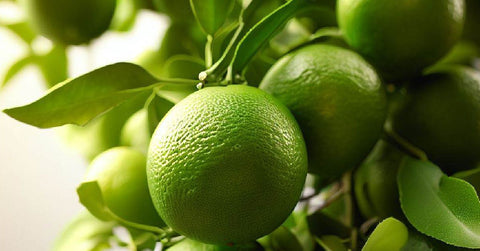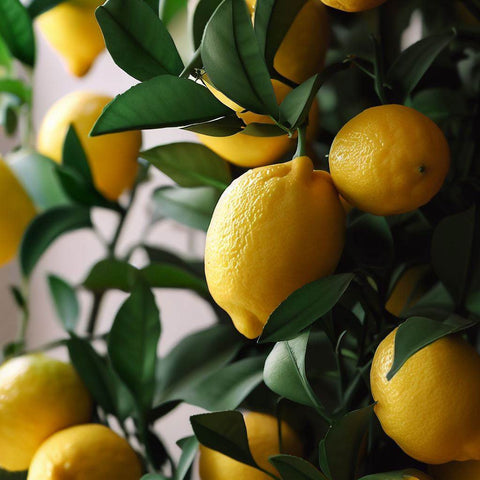Introduction

The key lime tree, also known as Citrus aurantifolia, is a tropical citrus tree famous for its small, round, and highly aromatic fruits. Key limes are widely recognized for their use in the famous Key lime pie, but they offer much more than just a delightful dessert ingredient. In this comprehensive guide, we will explore the world of key lime trees, including their appearance, cultivation techniques, proper care, harvesting methods, benefits, varieties, common issues, and more. Let's dive into the captivating world of key lime trees and unlock the secrets of growing these tangy and versatile citrus fruits.
Appearance
Key lime trees are small to medium-sized evergreen trees that can reach a height of 6 to 13 feet (1.8 to 4 meters). They feature glossy, dark green leaves with a lanceolate shape. The tree's branches often have thorns, so it's important to handle them with care. The fruits of the key lime tree are small and round, measuring about 1 to 2 inches (2.5 to 5 centimeters) in diameter. They have a thin, smooth, and yellow-green skin that turns yellow when fully ripe.
Cultivation
Key lime trees thrive in warm, tropical climates and are well-suited for USDA hardiness zones 10 to 11. However, they can also be grown in containers and brought indoors during colder months in cooler regions. Here are the key factors to consider for successful key lime tree cultivation:
Location
Choose a sunny location for your key lime tree, as it requires at least 6 to 8 hours of direct sunlight daily. The tree can tolerate partial shade, but full sun exposure is ideal for optimum growth and fruit production. Protection from strong winds is also beneficial.
Soil
Key lime trees prefer well-draining soil that is rich in organic matter. A slightly acidic to neutral soil pH ranging from 6.0 to 7.0 is suitable for their growth. If your soil is heavy and clayey, consider amending it with organic compost or sand to improve drainage.
Planting
When planting a key lime tree, dig a hole that is slightly wider and deeper than the root ball. Gently place the tree in the hole, ensuring that the bud union (the swollen area at the base of the trunk) sits slightly above the soil surface. Backfill the hole with soil, gently firming it around the roots. Water the tree thoroughly to settle the soil and remove any air pockets.
Care
Proper care is essential for the healthy growth and abundant fruiting of key lime trees. Here are some key care practices to follow:
Watering
Key lime trees require regular watering to keep the soil consistently moist. However, it's important to avoid overwatering, as waterlogged soil can lead to root rot. Water the tree deeply and thoroughly, allowing the top inch of soil to dry out between waterings. Adjust the frequency of watering based on weather conditions and the moisture level of the soil.
Fertilizing
To promote healthy growth and fruit production, it's recommended to fertilize key lime trees regularly. Use a balanced citrus fertilizer or a fertilizer specifically formulated for citrus trees. Follow the package instructions for application rates and frequency. Generally, it's advisable to fertilize the tree three times a year: in early spring, midsummer, and early fall.
Pruning
Pruning helps maintain the shape of the key lime tree, improves air circulation, and encourages new growth. Prune the tree during late winter or early spring, before the new growth emerges. Remove any dead, diseased, or crossing branches. Thin out the canopy to allow sunlight to reach all parts of the tree. Remember to sanitize your pruning tools to prevent the spread of diseases.
Mulching
Applying a layer of organic mulch around the base of the key lime tree can provide several benefits. Mulch helps conserve soil moisture, suppresses weed growth, and regulates soil temperature. Apply a 2- to 3-inch layer of mulch, making sure to keep it a few inches away from the trunk to prevent rotting.
Harvesting
Key limes are ready to be harvested when they reach their full size and develop a bright yellow color. They should feel slightly soft when gently squeezed. Depending on the climate, key limes can be harvested throughout the year, but the peak season is usually from summer to early fall. To harvest, simply twist or cut the fruit from the tree using pruning shears or scissors. Avoid pulling or tugging, as this can damage the branches.
Benefits
Key limes offer a range of benefits that make them a popular choice among home gardeners and culinary enthusiasts. Here are some notable benefits:
Culinary Uses
Key limes are widely used in cooking and baking, particularly in tropical and citrus-based dishes. They add a tangy and aromatic flavor to savory dishes, desserts, beverages, and even cocktails like the classic Key lime pie. The juice and zest of key limes are highly valued for their unique taste and versatility in various recipes.
Vitamins and Antioxidants
Key limes, like other citrus fruits, are rich in vitamin C, an essential nutrient that supports immune function and acts as an antioxidant in the body. They also contain other vitamins and minerals such as vitamin A, potassium, and folate.
Digestive Health
The natural acidity of key limes can aid digestion by stimulating the production of digestive enzymes. They are also a good source of dietary fiber, which promotes healthy digestion and helps prevent constipation.
Varieties
While the key lime is the most well-known variety, there are a few other lime varieties worth exploring:
Persian Lime

The Persian lime, also known as Tahiti lime, is a popular lime variety that is larger and less acidic than key limes. It has a bright green color and a juicy, seedless flesh. Persian limes are commonly used in cooking, bartending, and making limeade.
Kaffir Lime

The Kaffir lime is a unique lime variety known for its distinctive double-lobed leaves and strong citrus aroma. While its small, bumpy fruits are not typically used for their juice, the leaves and zest of the Kaffir lime are highly prized in Thai and Southeast Asian cuisine for their intense flavor.
Common Issues
Key lime trees can face certain challenges that gardeners should be aware of:
Citrus Canker
Citrus canker is a bacterial disease that causes raised corky lesions on the leaves, stems, and fruits of citrus trees. It can lead to defoliation and reduced fruit quality. To manage citrus canker, affected plant material should be pruned and destroyed, and copper-based sprays may be used as a preventive measure.
Citrus Pests
Common pests that can affect key lime trees include aphids, citrus leaf miners, and citrus scale insects. Regular monitoring, proper cultural practices, and the use of organic or chemical controls can help manage these pests effectively.
Root Rot
Overwatering or poorly drained soil can lead to root rot, a fungal infection that affects the roots of the tree. Symptoms include yellowing leaves, wilting, and stunted growth. To prevent root rot, ensure proper drainage, avoid overwatering, and plant key lime trees in well-draining soil.
Conclusion
In conclusion, cultivating and caring for key lime trees can be a rewarding and enjoyable experience. With their aromatic fruits and versatile uses in cooking and baking, key limes bring a tangy burst of flavor to a variety of dishes. By providing proper cultivation techniques, regular care, and attention to common issues, you can enjoy the beauty and bounty of your own key lime tree. So, roll up your sleeves, embrace the tropical allure of these citrus gems, and savor the zesty delights they have to offer.
FAQ
1. Can I grow a key lime tree in a container?
Yes, key lime trees can be grown in containers, making them suitable for patio gardens or indoor cultivation. Just ensure the container has good drainage, use well-draining soil, and provide adequate sunlight and care.
2. How long does it take for a key lime tree to bear fruit?
Key lime trees typically start bearing fruit within three to five years after planting. However, the exact timing can vary based on growing conditions and the tree's overall health.
3. Can I grow a key lime tree from seeds?
Yes, key lime trees can be grown from seeds. However, keep in mind that trees grown from seeds may not necessarily produce fruits identical to their parent tree. It's best to obtain a grafted or nursery-grown key lime tree for more consistent fruit quality.
4. How do I protect my key lime tree from frost?
Key lime trees are sensitive to frost and cold temperatures
5. How often should I prune my key lime tree?
Pruning key lime trees is typically done in late winter or early spring before the new growth starts. It's recommended to prune annually to remove dead, damaged, or crossing branches, and to maintain the desired shape and size of the tree.
6. Can I grow a key lime tree from cuttings?
Yes, key lime trees can be propagated from cuttings. Take 6 to 8-inch long stem cuttings from a healthy tree, remove the lower leaves, and plant them in a well-draining rooting medium. Keep the cuttings in a warm, humid environment until they develop roots.






























Comments (0)
There are no comments for this article. Be the first one to leave a message!